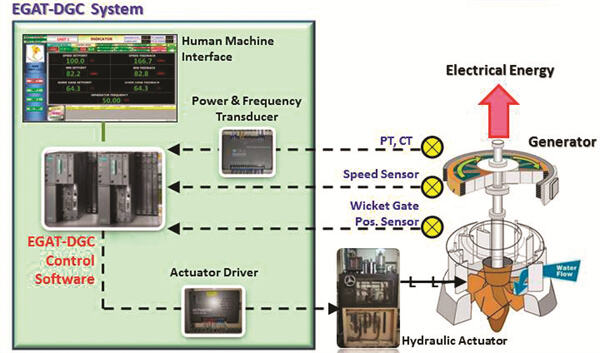
The electrical system of a hydropower station can generally be divided into several parts, such as hydroelectric generators, generator voltage equipment, main transformers, high-voltage power distribution devices, auxiliary power systems, and grounding systems, as shown by the solid line boxes in the following figure.
The hydroelectric generator and the main electrical wiring are like the heart and aorta of the electrical system. The hydroelectric generator converts the rotating mechanical energy output by the hydro turbine into electrical energy, which is the source of the electrical energy output of the hydropower station. The efficiency of large hydro-generators can generally reach about 98%. At present, the maximum capacity of hydroelectric generators in operation in China is 889MVA. The electrical main wiring is to connect the hydroelectric generator, generator voltage equipment, main transformer, high voltage distribution device, power system, etc. in an appropriate way to achieve the functions of electric energy transmission, boost, collection, distribution, and sending .
The generator voltage equipment transmits the electrical energy generated by the hydroelectric generator to the main transformer. The return flow has the characteristics of high voltage and high current. The auxiliary power system and the excitation device of the unit are generally connected to the power supply from here. At present, the voltage levels of generators in hydropower stations have been put into operation up to 24kV. Considering the factors such as the peak participation of the hydropower station and the frequent switching of the unit, the generator-generator circuit breaker is often installed at the outlet of the turbine generator. The connecting conductor of the voltage loop of the generator of the large-capacity unit is usually a closed-phase bus.
The main transformer is the junction of the generator voltage equipment and the high-voltage power distribution device. It raises the generator voltage to the transmission voltage to reduce the transmission current, thereby effectively reducing the transmission loss and material cost of the power grid. In general, the larger the installed capacity and the longer the transmission distance, the higher the transmission voltage. At present, the transmission voltage level of hydropower stations in China is up to 750kV.
The high-voltage power distribution device is used to collect the electrical energy sent by the main transformer and send it to the power system through the outlet field. It mainly includes three types of open power distribution device, gas insulated metal enclosed switchgear (GIS) and hybrid power distribution device. Since most hydropower stations are located in high mountain and canyon areas, the layout of high-voltage distribution devices is often restricted. Therefore, GIS with the highest reliability and the most compact layout but relatively high cost has become the first choice for high-voltage distribution devices in hydropower stations in China. 800kV. High-voltage outgoing lines of hydropower stations usually use high-voltage power cables or gas-insulated metal enclosed transmission lines (GIL).
The plant power system obtains power from units, power grids, etc., and provides power to loads (points) such as power plant unit operations, lighting, public equipment, and dam area power equipment according to the needs of power facilities. The grounding system is used to ensure the normal operation of the electrical system of the hydropower station and the safety of people and equipment. At present, the grounding system of the hydropower station makes full use of the reservoir water, underwater steel structure and natural grounding body to reduce the grounding resistance. Auxiliary power system and grounding system are important guarantees for the safety, reliability and economic operation of hydropower stations. Their equipment and wiring are widely distributed in various parts of hydropower stations.